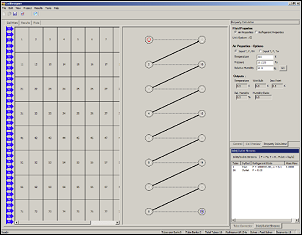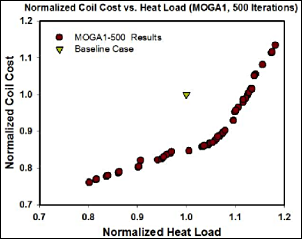A sophisticated tool for design and optimization of air-cooled heat exchangers
- A highly customizable tool for simulating tube-fin, micro-channel, wire-fin, and flat tube coils, for air-to-refrigerant heat exchangers and tube-in-tube heat exchangers for fluid-to-fluid heat exchangers
- Model validated with 19 experimental data sets (publications available)
Refrigerant Options
- Pure fluids (R134a, CO2 etc.), and pre-defined mixtures (R410A, R404A, R407C etc.)
- Single phase fluids (e.g., water, glycols etc.)
- Plus all refrigerants available in NIST REFPROP 7.0/8.0, including new fluids such as R1234yf
- User-defined refrigerant mixtures (created on-the-fly), and user-defined external fluid properties (via DLL’s or .FLD files)
- Proprietary implementation for popular refrigerant properties leading to order or magnitude improvement in execution time compared to NIST REFPROP 8.0
Air Side Options
- Multiple fins types (plate, louver, slit, wavy, or bare tubes), with dry air and wet air
- Can account for 2-D air maldistribution on coil face area in velocity, temperature and humidity
- Built-in velocity profiles plus the option to create velocity profiles and to load velocity profiles from CFD output
- Load a fan curve to allow the program to solve for the air flow rate
Flexible Tube-circuitry
- Number of tube rows and columns limited by available computer memory only
- Built-in counter-flow circuitry options (tube-fin) and pass-based inputs (microchannels)
- Custom circuitries can be created by connecting tubes on-screen via consecutive mouse clicks
Heat Transfer and Pressure Drop Correlations
- Popular heat-transfer (62), pressure drop (44), and void fraction (15) correlations implemented in the tool for different refrigerant phases, along with user specified correction factors
- Refrigerant specific (e.g., two-phase R410A, supercritical CO2) correlations
Post-processing and Results
- Detailed results available including all properties of interest for all segments and tubes
- Plot for heat load vs. tubes and circuits, outlet air temperature profile and 3-D plots
- 3-D coil drawing with overlaid results
- Export results (and all inputs) to spreadsheet for archiving and further analysis
Sensitivity / Parametric Studies
- Parametric studies can be conducted with one, two or more parameters simultaneously
- Coil dimensions, refrigerant and air side inlet conditions and tube passes can be varied
- Results can be plotted and exported to spreadsheet
Interoperability
- Coils are saved in portable data format and thus can be loaded from any other application
- External communication interface is provided for .NET platform and for Microsoft Excel. Interfaces for other applications or platforms can be developed
Customization Options
- User-defined correlations for heat transfer and pressure drop (refrigerant and air) can be added
- User-defined refrigerants can be added to the program
- User-defined coefficients for standard heat transfer and pressure drop equations can be provided
- Optionally the program allows the user to develop a coefficient file and encrypt it for distribution
- User-defined cost correlations can be added
Optimization Capabilities
- Single and multiobjective genetic algorithms are built-into the program
- The algorithm systematically searches the entire design space defined by the user for optimum coils that meet certain performance (e.g. heat load and pressure drop) requirements
- Results are displayed as a trade-off (Pareto) set between cost and performance
Support Options
- Support available via email, phone and web-based meetings
- ISOC personnel also assist the users in integrating CoilDesigner with their in-house tools
 CoilDesigner Multiobjective Optimization with Genetic Algorithms (GA)
CoilDesigner Multiobjective Optimization with Genetic Algorithms (GA)
- Design Options: Tube length, fin density, number of fans, circuits, fan types, motor types, resulting in a total of 125000 possible coils
- The GA evaluated 5000 coils and produced the trade-off set shown on the right
- For the same heat load as the baseline coil, the cost can be reduced by up to 15% or, for the same cost, the heat load can be increased by 12 percent
- GA can be used to systematically search the large design space and find optimum solutions for coil design problems
Top